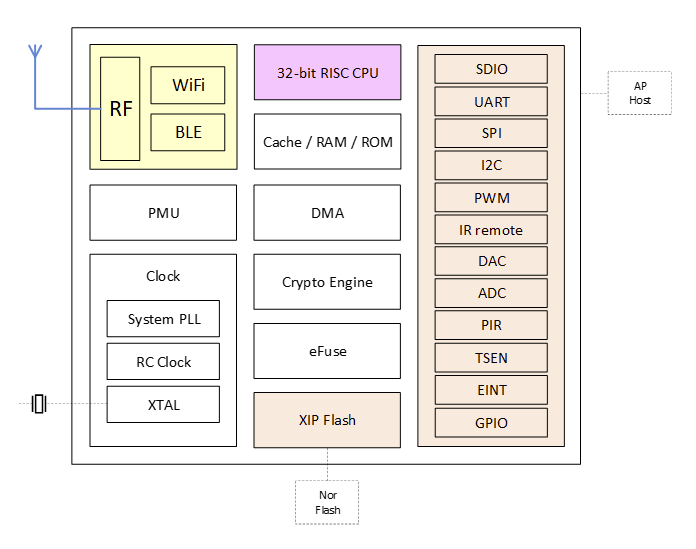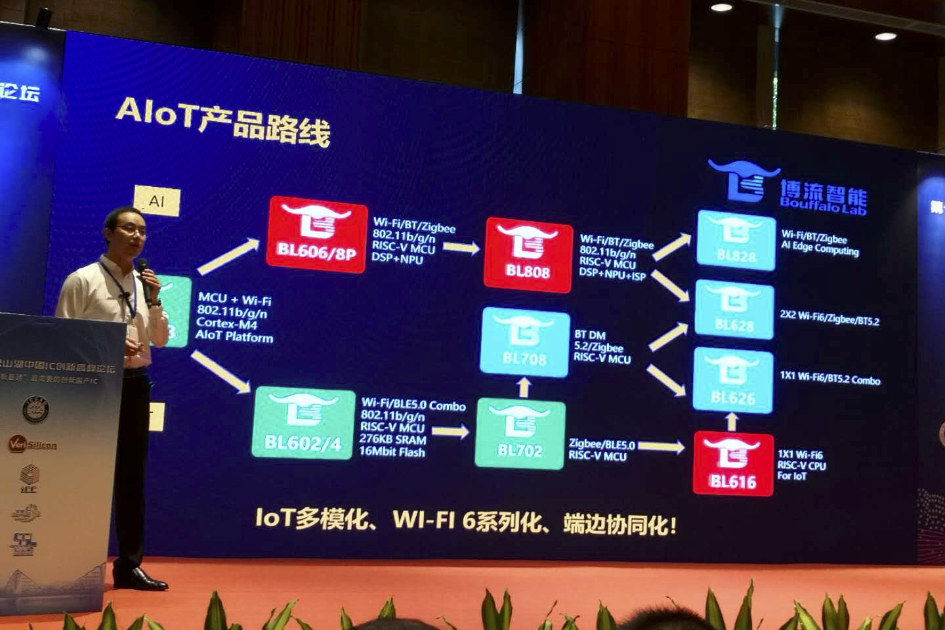Hisilicon Hi3861 may be the first RISC-V WIFI SoC we’ve reported on, but due to political uncertainties and security concerns, supplies may not be available outside of China.
So alternatives are welcomed, and Nanjing-based Bouffalo Lab (not a typo, in Chinese) has recently introduced BL602 and BL604 32-bit RISC-V WiFi and Bluetooth LE SoC for low-power IoT applications that are supposed to compete against ESP8266 in terms of price but with higher performance and additional features. The BL602 will also be integrated into an upcoming Sipeed Longan-series board, and potentially a new IoT board from Pine64.
 BL602 / BL604 key features & specifications:
BL602 / BL604 key features & specifications:
- MCU subsystem – 32-bit RISC-V CPU with FPU with dynamic frequency from 1MHz to 192MHz, L1 cache
- Memory – 276KB SRAM on-chip
- Storage
- 128KB ROM, 1Kb eFuse, and optional Embedded Flash on-chip
- XIP QSPI flash support
- Wireless
- Wi-Fi 4 – 802.11 b/g/n @ 2.4 GHz
- Bluetooth 5.0 LE
- Wi-Fi Fast connection with BLE assistance
- Wi-Fi Security – WPS/WEP/WPA/WPA2/WPA3
- STA, SoftAP, and “sniffer” modes
- Integrated RF balun, PA/LNA
- WiFi Tx: 21 dBm; WiFi Rx: -98 dBm
- Peripherals and I/Os
- SDIO 2.0 slave (AP-Host)
- SPI master/slave, 2x UART, I2C master/slave, 5x PWM channels
- ADC – 10-bit general DAC, 12-bit general ADC, 2x general analog comparators
- PIR (Passive Infra-Red) detection
- IR remote HW accelerator
- 16x flexible GPIOs (BL602) / 23x flexible GPIOs (BL604)
- 4x DMA channels
- RTC timer up to One year
- 2x 32-bit general-purpose timers
- Clocks – Supports XTAL 24/26/32/38.4/40MHz, XTAL 32/32.768KHz, internal RC 32KHz & 32MHz oscillator, internal system PLL
- Security
- Secure boot
- Secure debug
- XIP QSPI On-The-Fly AES Decryption (OTFAD)
- AES-128/192/256
- SHA-1/224/256
- TRNG (True Random Number Generator)
- PKA (Public Key Accelerator)
- Debugging – JTAG
- Supply Voltage – 2.1 to 3.6V
- Low power modes – Off, hibernate, power down sleep, and active
- Power consumption – Deep sleep: 0.5uA; WiFi Rx: 18 mA
- Package Type – 32-pin QFN (BL602) or 40 pin QFN (BL604)
- Temperature range – -40°C to 125°C
The specs are made of the information there is on Bouffalo website, plus extra information I found on the Internet. I first found about BL602 thanks to a Tweet by Sipeed.
Longan series (RISC-V) will add new boards:
1. RV32 WIFI+BT Soc up to 200MHz
2. ~300KB SRAM + 2MB in chip flash
3. as cheap as esp8266
what software env you want for this platform? mpy? rust?
what about PlatformIO support?— Sipeed (@SipeedIO) October 22, 2020
Somehow there seems to be a lot of people asking for Rust support, a high-level programming level that can also be used for embedded devices. But we may also get Arduino/PlatformIO and MicroPython support. Anyway, that’s the tweet where I learned about BL602 and that it would be as cheap as ESP8266. TL Lim, the founder of Pine64, also participated in the discussion and would consider launching a Pine64 BL602 board if an open-source toolchain is available.
The information we have so far is interesting, but it gets even better when we look at Bouffalo roadmap as posted on EDN China (in Chinese).
They have plenty of wireless RISC-V MCUs in the pipeline with BL606/BL608P featuring WiFi, Bluetooth, and Zigbee connectivity plus a DSP and AI accelerator, as well as BL808 adding an ISP for camera support. BL702 is designed for the smart home with Zigbee and BLE 5.0, and BL708 is similar but with Bluetooth 5.2 dual-mode (BLE + Bluetooth Classic). They even have a WiFi 6 RISC-V IoT chip (BL616), and other chips for AI edge computing (BL828), support for 2×2 MIMO (BL628), etc…
This looks promising, but we’ll have to see how software support progresses. There’s a developer website but I did not manage to register, and the forums are fairly empty right now, so there’s nothing much happening in public at this time.

Jean-Luc started CNX Software in 2010 as a part-time endeavor, before quitting his job as a software engineering manager, and starting to write daily news, and reviews full time later in 2011.
Support CNX Software! Donate via cryptocurrencies, become a Patron on Patreon, or purchase goods on Amazon or Aliexpress






already has sdk for this kind of board: https://github.com/SmartArduino/Doiting_BL
Thanks. I could notice they had a board as well, so I wrote about it: https://www.cnx-software.com/2020/10/25/bl602-iot-sdk-and-5-dt-bl10-wifi-ble-risc-v-development-board/
What’s a ‘dlexible’ GPIO? Flexible?
I’m all for more readily available chips like this, but what makes the difference is the software support. ESP has had years to get that organized. They’ve also put some effort into supporting their chips which has had no little part in their success. They’ve even hired brilliant people from the ‘scene’. Bouffalo has a lot of work ahead of them if they want to compete with Espressif. Because, in the end, it takes more than specs and prices to make a successful device.
They will have the support of the entire opensource community to get the software ecosystem going. Using an open ISA attracts lots of moment.
What are you basing that on? There isn’t one opensource community.
Just being RISC-V means they don’t have to put a lot of effort into compilers etc as long as they don’t make their chip subtly incompatible.. but that doesn’t give them a free ride with the other stuff they need like the other bits you want for anything beyond printf(“hello, world\n”);. i.e. An RTOS kernel, networking stacks, TLS and so on.
You can bet the SDK for this thing will be yet another mash up of gcc + newlib + lwip + some blobs + some very bad HAL layer code smothered over the top of it.
Among the asian vendors Espressif is the only one that has tried to make their stuff not a complete pile a garbage AFAIK.
Really people need to stop putting these sort of microcontrollers on WiFi. Use low power local area networking with these things and have them talk to a gateway running a recent Linux with most of the extra code written in Python or something instead of having an intern do it in C. That way when the microcontrollers inevitably get hacked the damage is as minimal as possible.
True that. I replied on their tweet. They seem to be interested. So let’s see how helpful they will be with the implementation.
https://twitter.com/Citrullin/status/1319888636645703686
“Among the asian vendors Espressif is the only one that has tried to make their stuff not a complete pile a garbage AFAIK.”
lmao, seriously? You mean the SDK which is bound to FreeRTOS and you have to use FreeRTOS in order to use their SDK? Yeahh, not the best example for a good SDK tbh.
There is some official contribution to get zephyr working
Espressif has already shipped this – the ESP32-C3. Same RISC-V core. It costs under $1 in quantity. And it has the Espressif SDK — working software!
Here is C3 module for $2.49 from retail store.
https://www.aliexpress.com/item/1005002810002798.html
Perhaps I search the wrong terms, but I cannot find the maker here https://riscv.org
You don’t need to be a member to make RISC-V chips. It’s just needed to vote for changes and/or use the logo.
I’ve just been told BL602 is based on SiFive E24.
The datasheet is now hosted on Pine64 website: http://files.pine64.org/doc/datasheet/padi-ii/BL602_BL604_DS_Datasheet.pdf
Pine64 has already started to develop a BL62 module and board.
The form factor of the module will be the same as Pine64 PADI IoT stamp.
It’s not sure they go ahead yet, but if they do the plan is to have the module for $1.99 and the complete EVB for $3.99.
Thanks for your articles. SDK had been open at https://github.com/bouffalolab/bl_iot_sdk , and more docs following.
Where is the firmware for micropython?
It looks like MicroPython for BL602 is not available yet. I’m not even sure whether anybody has started to work on it.